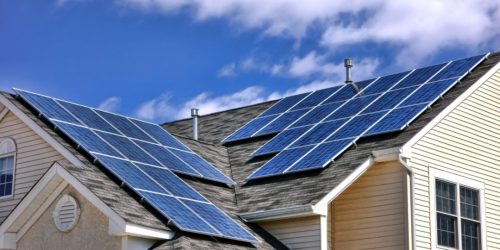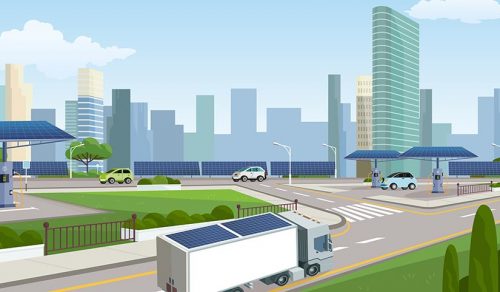The dominant trend in EV batteries is that bigger is better. Maybe with speedier charging, automakers could do more with less.
ISSAM MUDAWAR, A professor of mechanical engineering at Purdue University, has been solving heat-related emergencies for 37 years. They often follow a pattern. Anyone who dreams up a supercomputer, or new avionics for a fighter jet, will eventually face the same problem: Fancy electronics, packed with trillions of transistors, generate tremendous amounts of heat. So the dreamers come to Mudawar, the guy who studies thermal management for a living. “It always seems that cooling is the last thing people think about,” he says.
A couple of years ago, Mudawar was approached by Ford with a more humble problem: a charging cable. Like other automakers, Ford is in a race to deliver electric vehicles that power up quickly. But there’s a problem with moving electrons faster: It brings the heat. If the goal is to charge up your electrical vehicle in, say, five minutes, that extra current meeting resistance means temperature-related problems inside the battery and out. The cord, in particular, becomes a superheated bottleneck.
Mudawar has been solving a problem that doesn’t really exist yet. The US Department of Energy has defined so-called “extreme” fast charging as adding 200 miles of range within 10 minutes. This is reachable with existing charging stations and cables, the capabilities of which batteries have yet to max out, in part because of their own heating concerns. Mudawar’s work meanwhile anticipates a future when filling up a car with electrons can perhaps even rival the convenience of the gas pump.
Recently, the trend in electric vehicles is that bigger is better. Automakers now target 400 miles of range as an antidote to “range anxiety,” while at the same time they are electrifying staples of American roads—Chevy Silverados, Ford F-150s, Hummers. Massive cars plus massive range requirements mean totally giant batteries. Unsurprisingly, this comes with a trade-off: Charging up those big batteries takes extra time. The fastest option might be getting a full charge in 30 or 40 minutes from state-of-the-art highway chargers, which account for about 5 percent of EV fill-ups, according to the DOE. Mostly, though, these cars are designed for drivers who can plug in at home and let that massive battery charge up all night.
Combining the two is difficult, explains Ahmad Pesaran, an energy storage expert at the National Renewable Energy Laboratory. A phrase like “five-minute charging” means something very different if you’re charging a 200-kilowatt-hour battery, like the one found in a Hummer, versus the 40-kwH battery in a Nissan Leaf. Those big batteries need far more energy, and they have structural barriers that make charging itself hard to do quickly. That will likely require new chargers and battery strategies, fancy new cables, maybe even upgrades to the transmission lines that power the chargers so they can handle a massive spike in demand. “I question the wisdom of why we need to have 500-mile range in an electric car and also want fast charging in five minutes,” he says. “Where do you want to go? How many times do you need to do that?” But, he adds, it might just be inevitable.

CURRENTLY, MOST CARS can’t take advantage of the most powerful charging stations we already have, says Chao-Yang Wang, a battery researcher at Penn State University. The reasons are found mostly within the battery itself, most notably a phenomenon called lithium plating. When batteries charge up, lithium ions nestle inside an anode made of graphite. In an effort to pack more energy into batteries, this material has been engineered to be pretty thick, so it can hold more ions. But this becomes an obstacle for charging. As the current gets more intense, those ions can’t get inside the thick anode material fast enough. So instead they build up on its surface as lithium metal—they plate. And once that happens, there’s no going back. The battery gradually loses access to those ions, and so loses its ability to charge up fully.
A variety of labs and startups have developed potential solutions to that problem, including changing the anode to silicon or lithium metal, instead of graphite. Wang’s solution, which was published last year in Nature Energy, is to add more heat to the equation. A thin strip of nickel foil inside the battery quickly cooks the battery up 60 degrees Celsius—a temperature at which the lithium ions move more quickly to find their seats in the anode. This allows a higher current to flow into the battery without causing plating, shaving off valuable minutes from charging.
Wang envisions 10-minute charging of a battery that’s between 40 and 50 kW. That’s in line with the DOE’s extreme charging definition—plenty of energy to get 200 miles of range in an efficient car, though about half the energy stored inside a top-of-the-line Tesla, or a quarter of the battery power of the upcoming Silverado. And to Eric Rountree, head of business development for EC Power, a company commercializing Wang’s technology, that’s not a bad thing. “One of the concerns we have is that where the current EV landscape is headed is antithetical to where we should go,” he says. “We want better utilization of renewable energy.” That means cars that put less strain on the grid, and that use fewer natural resources in their batteries.
Elsewhere in the world, shorter-range vehicles are already popular, even without fast charging. He points to the example of China, where miniature EVs powered by smaller batteries are regularly best sellers, and automakers like Tesla have made strides investing in iron phosphate batteries that pack somewhat less energy but require fewer scarce materials like cobalt and nickel than the most range-optimized designs.
In the US, there may also be an audience for lower-range vehicles, especially with fast-charging in the picture. “People in apartments don’t have chargers in their home,” says Pesaran of NREL. “They’d definitely like to have a station that gets them charged up in five or 10 minutes.” You take your EV somewhere convenient—the converted gas station around the corner from your house, or on the way to work, and fill it up with electrons.
Jessika Trancik, a professor studying energy systems at MIT, says range will likely remain of interest to EV buyers. Whatever kinds of fast-charging technologies are developed, it will take time to build them out. The important thing is to be strategic about where they’re installed. “One of the reasons you don’t want to install currently available fast chargers everywhere is the cost,” she says. She says faster charging shouldn’t mean stinting on investment in slower charging that’s available to all—like street-side chargers for apartment dwellers. That’s good for widening access to EVs, and it’s likely good for the grid too.
PESARAN SUSPECTS THAT automakers will keep pushing for more extreme charging speeds—more range in less time—given the way electric car range and charging capabilities are being marketed to overcome skeptical buyers. Which is why Mudawar’s heat-tolerant charging cable may matter. His lab approached the overheating problem with what’s known as “two-phase cooling.” Typical systems rely on liquid flowing through an insulating layer that picks up heat from the charging cable. His design is similar, except that it incorporates boiling—just a little of it, at the meeting point between the coolant and the cable. These tiny little bubbles, which are allowed to recondense rather than being released as steam, translate into enormous levels of cooling, allowing the cable to handle roughly five times the current of a state-of-the-art Tesla Supercharger.
But it’s still a prototype confined to a lab station, and to a study that was published in the International Journal of Heat and Mass Transfer last year. Mudawar hasn’t tested the cable’s current-carrying abilities on cars yet—the batteries aren’t ready for that type of current yet. One issue is the heat imbalance such an immense charging capability creates. Fast-charging a big car battery will generate lots of heat within minutes. But it will use that energy to power the motor at a much slower pace—over hours or potentially days—generating far less heat. So is it worth putting a bunch of new cooling components on a car just for that five to 10 minutes of charging? Already, most of the weight of a battery pack is not battery cells, but rather the packaging, electronics, and cooling equipment.
There are other possible solutions, Mudawar points out. Some people are exploring the idea of injecting coolant into the vehicle during charging, chilling the battery pack while it charges without adding weight to the car. But that will require a rethink of how cars are designed. That, along with everything from the batteries to cables, plugs, and transmission lines will need to be rethought. It all needs to hold up to the heat, notes Mudawar, who recently announced a new center at Purdue for thermal management of fast charging. “The technologies of today will not be capable of tackling those new requirements,” he says. In other words, don’t save the cooling problem for last.
Source: Gregory Barber, wired.com
Image source: Andreas Schlegel




